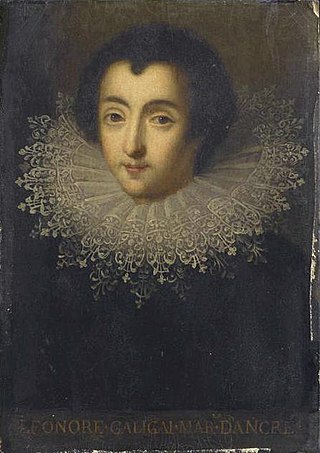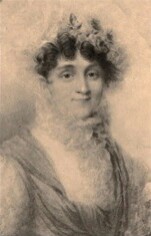
A lady-in-waiting or court lady is a female personal assistant at a court, attending on a royal woman or a high-ranking noblewoman. Historically, in Europe, a lady-in-waiting was often a noblewoman but of lower rank than the woman to whom she attended. Although she may either have received a retainer or may not have received compensation for the service she rendered, a lady-in-waiting was considered more of a secretary, courtier, or companion to her mistress than a servant.

Angélique Victoire de Durfort-Civrac, Countess of Chastellux, was a French courtier. She served as dame d'honneur to Madame Victoire, daughter of King Louis XV, from 1786 to 1799.

Anne d'Arpajon, comtesse de Noailles was a French noblewoman and court official. She served as the dame d'honneur of two Queens of France, Marie Leszczyńska and Marie Antoinette. She was called "Madame Etiquette" by Marie Antoinette for her insistence that the minutiae of court etiquette could never be altered or disregarded.

Jacqueline de Longwy, Countess of Bar-sur-Seine, Duchess of Montpensier, Dauphine of Auvergne was a French noblewoman, and a half-niece of King Francis I of France. She was the first wife of Louis III de Bourbon, Duke of Montpensier, and the mother of his six children. She had the office of Première dame d'honneur to the queen dowager regent of France, Catherine de' Medici, from 1560 until 1561.

Louise Antoinette Lannes, Duchess of Montebello was a French courtier, dame d'honneur to Empress Marie Louise of France, and the second wife of Jean Lannes, one of Napoléon's ablest Marshals, who was nicknamed the Roland of the Grand Armée.. She was the daughter of senator and financier François Scholastique, Count of Guéhéneuc. She was the sister of general Charles Louis Joseph Olivier, Count of Guéhéneuc.

Bonne Marie Félicité de Sérent née de Montmorency-Luxembourg, was a French courtier. She served as dame d'atour to Princess Élisabeth of France in 1776–92, and as dame d'honneur to Marie Thérèse of France in 1799–1823.

Louise Charlotte de Noailles, was a French courtier and memoirist. She served as lady in waiting to Marie Antoinette from 1770 to 1791.

Dame d'atour was an office at the royal court of France. It existed in nearly all French courts from the 16th-century onward. The dame d'honneur was selected from the members of the highest French nobility. They were ranked between the Première dame d'honneur and the Dame du Palais.

Surintendante de la Maison de la Reine, or only Surintendante, was the senior lady-in-waiting at the royal court of France from 1619 until the French revolution. The Surintendante was selected from the members of the highest French nobility.

Première femme de Chambre was an office at the royal court of France.

Laure Auguste de Fitz-James, Princesse de Chimey was a French courtier. She served as lady-in-waiting to Queen Marie Antoinette from 1770 to 1791.

The Dame du Palais, originally only Dame, was a historical office in the Royal Court of France. It was a title of a lady-in-waiting holding the official position of personal attendant on a female member of the French Royal Family. The position was traditionally held by a female member of a noble family. They were ranked between the dame d'atours and the Fille d'honneur. They had previously been styled 'Dames'.

Marie Catherine de Senecey née de La Rochefoucauld (1588–1677) was a French courtier. She served as Première dame d'honneur to the queen of France, Anne of Austria, from 1626 until 1638, and royal governess to king Louis XIV of France and his brother from 1643 until 1646.

Jeanne Charlotte du Luçay née Papillon d'Auteroche (1769-1842), was a French court official, Dame du Palais to Empress Joséphine and Dame d'atour to Empress Marie Louise of France.

Madeleine of Savoy (1510–1586) was a French court official, Première dame d'honneur to the queen of France, Elisabeth of Austria, from 1570 until 1574.
Jeanne de Dampierre, née de Vivonne was a French court official. She served as Première dame d'honneur to the queen of France, Louise of Lorraine, from 1575 until 1583.

Fulvie de Randan, née Pic de Mirandole (1533–1607) was a French court official. She served as Première dame d'honneur to the queen of France, Louise of Lorraine, from 1583 until 1601.
Inés Enríquez y Sandoval or Inés Enríquez Tavera de Saavedra, 1st Countess of la Torre was a Spanish and later French court official. She served as Première dame d'honneur to the queen of France, Anne of Austria, from 1615 until 1618.
Laurence de Montmorency (1571–1654) was a French court official. She served as Première dame d'honneur to the queen of France, Anne of Austria, from 1615 until 1624. Until 1618, she shared her office with Inés de la Torre.
Marie Françoise de Brancas (1650-1715), Princess of Harcourt and Marquise of Maubec, was a French aristocrat and courtier during the reign of Louis XIV. She was a lady-in-waiting to Queen Marie Thérèse and later became an intimate friend of Madame de Maintenon, the King's morganatic second wife.

















